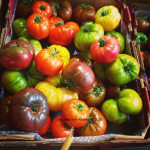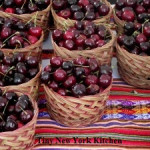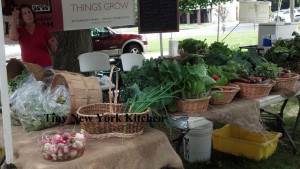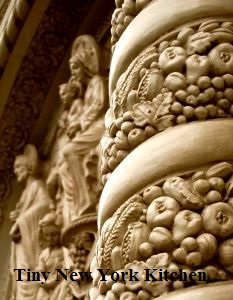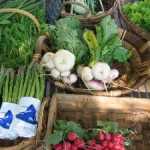Certain Produce Shouldn’t Be Stored In The Refrigerator
With some fruits and vegetables cold temperatures can lead to unsavory textures and flavors. Let tomatoes sit on the counter at room temperature, and store onions, garlic, and potatoes separately in a cool, dark place in perforated baskets or bins to allow for good airflow. Make sure to keep all fresh produce away from direct sunlight.
Onions & Garlic can lose crispness and become moldy when exposed to the refrigerator’s moisture. They can also impart their flavors on foods stored nearby.
Tomatoes flavor often diminishes when they’re chilled, and the texture can turn mealy as the cold temperature breaks down the membranes inside the fruit.
Potatoes starch content converts to sugar when cold, which leads to an unpleasantly sweet taste and discoloration when they’re cooked.
“Work With What You Got!”
© Victoria Hart Glavin Tiny New York Kitchen All Rights Reserve
 Constitution Week – Foods of Our Forefathers Part III
Constitution Week – Foods of Our Forefathers Part III
The abundance of meat in America was a major change in the diet of the early settlers. Rabbits and squirrels were available year-round nearly everywhere, plus deer and other large game in many regions. As settlers moved west, buffalo gained importance in the diet. Fish, shellfish and wild fowl became common food, and they were all essentially “free.” The existence of these various forms of game was a literal life saver in times of uncertain crops and unbroken land. The game gradually diminished, of course, as the population expanded and settlers pushed west, but it provided a large share of the diet in early and frontier days.
Ham, of course, appeared on almost every settler’s table, rich or poor. It might be the only meat served at a meal or it might appear in company with more exotic roasts and fowl, but it was always there – breakfast, dinner and supper.
Corn was also a staple of the colonists, either fresh in summer, or as hominy or corn meal all year. Corn was also put to another use by an early Virginian, Captain George Thorpe, who may have been the first food technologist in America as he invented Bourbon whiskey shortly before he was massacred by the Indians in 1622.
Meal patterns for working people in rural early America were very different from those common today. Breakfast was usually early and light which consisted of bread, hominy grits, and sometimes fruit in season. Coffee, which was a new beverage at the time, was popular that is if it was available. A drink made from caramelized grain was sometimes substituted. Chicory was popular in the South, either alone or used to stretch the coffee. Tea was often made from local leaves such as sage, raspberry or dittany. Alcohol in some form was often served.
Breakfast in more elegant homes or large plantations might be later in the morning, and include thinly sliced roast and ham.
Dinner was served somewhere between midday and midafternoon, depending on the family’s circumstances, and was the big meal of the day. There was almost always ham, as well as greens (called sallat), cabbage and other vegetables. In the proper season, special dainties would appear – fresh fruits and berries, or fresh meat at appropriate butchering times.
Desserts could be simple such as a scooped out pumpkin, baked until done and then filled with milk, to be eaten right out of the shell. Or dessert could be more complex such as ice cream or other fruit flavored frozen pudding or a blanc mange. Blanc mange was prepared from milk and loaf sugar, flavored with a tablespoon or two of rosewater, thickened with a solution of isinglass (derived from fish bladder, soaked overnight in boiling water). This mixture was boiled for 15 to 20 minutes, then poured into molds to set.
If isinglass was not available (most was imported from England), homemade calves foot jelly could be substituted, but eh dessert was not as fine.
Various alcoholic beverages, including wines, applejack, “perry” (hard cider made from pears), or beer were commonly consumed.
In winter, peaches and other fruit disappeared from the dinner table, to be replaced by dishes made from stored apples and dried fruit of various sorts. Soups or broths also took their place. Milk grew scarce as cows “dried up” in the short days. Vegetables gradually decreased in variety as stored crops wilted.
Apples quickly became a staple in early America. Orchards were easy to start, required a minimum of care, and apples stored well. Housewives devised a multitude of “receipts,” including sauces and butters for off-season, as well as many using dried apples.
Supper was late and a light bread and butter, some of the left-over roast from dinner, fruit (fresh if in season, pickled and spiced otherwise), and coffee or tea.
To Be Continued…
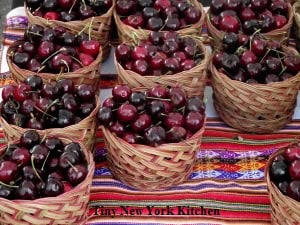 Fairfield County (& Surrounding Areas) Farmers’ Markets
Fairfield County (& Surrounding Areas) Farmers’ Markets
Summer is officially here and Farmers’ Markets are in full glory! Here is a list of a good number of Fairfield County Farmers’ Markets. No doubt I may have missed a few, but here is a good guide for some farm to fork eating.
Bethel Farmers’ Market: Saturdays 9am to 1pm, From June 29th to November 2nd, Location is Fairfield County Extension Center, 67 Stony Hill Road (Route 6), Bethel, CT. For more information go to www.bethelfarmersmarket.org.
City Center Danbury Farmers’ Market: Fridays 11:30am to 5:30pm, From June 28th to October 25th, Location is at Kennedy Park on Main Street (across from the bus station), Danbury, CT. For more information go to www.citycenterdanbury.com.
City Seed Farmers’ Markets: Multiple New Haven Locations: Wooster Square, Saturdays 9am to 1pm, From May 4th to December 21st, Location is at Russo Park (Corner of Chapel Street & DePalma Court), New Haven, CT. Edgewood Park, Sundays 10am to 2pm, From May 5th to December 22nd, Location is at Corner of Whalley & West Rock Avenues, New Haven, CT. Downtown, Wednesdays 11am to 3pm, From June 19th to November 27th, Location is at New Haven Green at Temple & Chapel Streets, New Haven, CT. Fair Haven, Thursdays 2pm to 6pm, From July 11th to October 31st, Location is at Corner of Grand Ave & Poplar Street, New Haven, CT. The Hill, Fridays 11am to 2pm, From July 12th to October 25th, Location is at Connecticut Mental Health Center (Corner of Park & South Streets, New Haven, CT. For more information go to www.cityseed.org.
Darien Farmers’ Markets: Wednesdays 11am to 4pm, From May 29th to Christmas, Location is in the Municipal Parking Lot off of Mechanic Street which is behind the firehouse on Boston Post Road, Darien, CT. For more information go to www.darienfarmersmarket.net.
Fairfield-Greenfield Hill Farmers’ Market: Saturdays 11am to 4pm (Rain or Shine), From May to October, Location is at 75 Hillside Road (Between Hillside & Bronson), Fairfield, CT. For more information call: 203-259-8786
Georgetown Farmers' Market: Sundays 10am to 2pm, From June to October, Location is in the Village of Georgetown, 4 Old Mill Road, Georgetown, CT. For more information go to www.georgetownctfarmersmarket.com.
Greenwich Farmers’ Market: Saturdays 9:30am to 1pm, From May 18th to the Saturday before Thanksgiving, Location is at the Commuter Parking Lot (Corner of Arch Street & Horseneck Lane), Greenwich, CT.
John Jay Homestead Farm Market: Saturdays 9am to 1pm, From June 22nd to October 12th, Location is at 400 Jay Street, Katonah, New York. For more information go to www.johnjayhomestead.org.
New Canaan Farmers’ Market: Saturdays 10am to 2pm, From May 11th to November 23rd, Location is at Old Center School parking lot at South Avenue (Maple Street & Main Street), New Canaan, CT. For more information go to www.newcanaanfarmersmarket.net.
Old Greenwich Farmers’ Market: Wednesdays 3pm to 6pm, From May 29th to TBD, Location is at Presbyterian Church in Old Greenwich at 38 West End Avenue, Old Greenwich, CT. For more information go to www.oldgreenwichfarmersmarket.com.
Rowayton Farmers’ Market: Fridays 12pm to 5pm, From May 31st to TBD, Location is at Pinkney Park, 177 Rowayton Avenue, Rowayton, CT. For more information go to www.rowaytonct.com/farmersmarket.
Stamford Farmers’ Market (French Market), Saturdays 9am to 3pm, From June to October. Location is at Bedford Street at Forest Street, Stamford, CT.
The Farmers’ Market at Fairfield Hills: Tuesdays 2pm to 6pm, From June 18th to Oct 22nd, Location is at Fairfield Hills Campus @ Wasserman Way, Newtown, CT. For more information contact Mary Fellows at 203-313-9908.
Village of Devon Farmers’ Market: Sundays 10am to 2pm, From July through October, Location is at 120 Bridgeport Ave (Route 1), Milford, CT. For more information check their Facebook page https://www.facebook.com/pages/Village-of-Devon-Farmers-Market/308864369173448
Weston Farmers’ Market: Saturdays 9am to 12pm, From Mid-June through October, Location is at the Weston Historical Society at Weston Road (Route 57) & High Acre Road, Weston, CT.
Wilton Farmers’ Market: Wednesdays 12:30pm to 5pm, From June 5th to September 25th. Location is at the Wilton Historical Society, 224 Danbury Road (Route 7), Wilton, CT. For more information go to www.wiltonfarmersmarket.com.
Farmers’ Market at Gossett’s Nursery: Saturdays 9am to 1pm, Location is at Gossett’s Nursery, 1202 Old Post Road (Route 35), South Salem, New York. For more information call 914-763-3001.
Sunday Farmers’ & Bakers’ Market & Second Sunday Antiques Market: Sundays 11am to 4pm. Location is at Antiques & Tools of Business & Kitchen, 65 Westchester Avenue, Pound Ridge, New York. For more information call: 914-764-0015 or 914-764-5122.
**Make Sure To Check Listings Before Heading Out As Things Are Subject To Change!
Here are some super easy, but versatile Pasta Salad Ideas from Tiny New York Kitchen. All you need to do is add 3 cups of cooked & chilled pasta (of your choice) and 1 tablespoon of extra virgin olive oil to one of these inspiring combinations. Try them all throughout the summer for a whole treasure trove of side salads. If you want to make any of these a main dish then add 1 pound of protein such as grilled chicken breasts, grilled flank steak, grilled shrimp, grilled tuna (or canned tuna) or tofu. All recipes below serve 4.
For the Pasta: Cook 3 Cups of Pasta, Toss With 1 Tablespoon Extra Virgin Olive Oil & Then Chill Until Ready To Use. Add the Pasta to One of the Salad Combinations Below.
Nutty Beans & Greens
1 Cup Trimmed & Steamed Haricot Verts
1 Cup Baby Arugula
3 Tablespoons Toasted & Chopped Walnuts
1 Ounce Shaved Parmigiano-Reggiano Cheese
Snow Peas & Carrots
1/2 Cup Grated Carrot
1 Tablespoon Soy Sauce
1/2 Cup Thinly Sliced Snow Peas
1/2 Cup Shredded Red Cabbage
1/4 Cup Dry Roasted Peanuts
Cheesy Chickpea & Pesto
1/2 Cup Cooked Chickpeas
1 1/2 Ounces Crumbled Feta Cheese
1 Cup Halved Grape Tomatoes
1 Tablespoon Prepared Pesto
Mediterranean Medley
1/3 Cup Chopped Fresh Basil
1/2 Cup Thinly Sliced Cucumber
1 Cup Halved Cherry Tomatoes
1 1/2 Ounces Crumbled Feta Cheese
1 1/2 Ounces Sliced Kalamata Olives
Peppery & Nutty
1 Cup Arugula
2/3 Cup Thinly Sliced Radishes
3 Tablespoons Toasted & Chopped Walnuts
2 Ounces Crumbled Goat Cheese
Melon, Mint & Parm
1/2 Cup Fresh Cubed Cantaloupe
2 Tablespoons Fresh Mint Leaves
2 Ounces Thinly Sliced Prosciutto
1 1/2 Ounces Shaved Parmigiano-Reggiano Cheese
Freshly Ground Pepper
Cherry Almond Crunch
3/4 Cup Pitted Halved Fresh Cherries
1/4 Cup Toasted & Thinly Sliced Almonds
2 Tablespoons Chopped Fresh Basil
1 1/2 Ounces Crumbled Goat Cheese
Picnic Superstar
1/3 Cup Sliced Avocado
1/4 Cup Red Bell Pepper Strips
1/4 Cup Fresh Corn Kernels
2 Cooked Crumbled Center Cut Bacon Slices
2 Ounces Quartered Fresh Baby Mozzarella Balls
Summer is here and why pay top dollar going out when you can make delicious hot dogs at home? Here is a guide to the different ways Americans make their frankfurters around the country. I had the Sonoran style hot dogs while I was in Tucson in February and absolutely loved them.
New York Style
Served with brown or German mustard and sauerkraut or onions cooked in tomato paste.
Chicago Style
Served on a poppy seed bun with mustard, pickle relish, sport peppers, onions, tomatoes, dill pickles and celery salt. Pepperoncini can be substituted for sport peppers.
Kansas City Style
Served on a sesame seed bun with brown or German mustard, sauerkraut and Swiss cheese.
Atlanta “Dragged Through The Garden” Style
Serve topped with coleslaw.
Detroit “Coney” Style
Served with chili, onions, mustard and cheddar cheese.
Seattle Style
Served with cream cheese and grilled onions.
Phoenix/Tucson “Sonoran” Style
Served as a bacon-wrapped hot dog with pinto beans, onions, tomatoes, mustard, mayo, jalapeno peppers and cheese.
Austin “Tex-Mex” Style
Served with queso, guacamole and crushed tortilla chips.
San Francisco “Wine Country” Style
Served with red wine caramelized onions and goat cheese.
Miami “Cuban” Style
Served with mustard, pickles and Swiss cheese.

“Food, one assumes, provides nourishment; but Americans eat it fully aware that small amounts of poison have been added to improve its appearance and delay its putrefaction.” – John Cage
There has been quite a bit of controversy these days about eating organic. Recent studies state that it really doesn’t matter if you eat organic foods or not. When something is labeled organic, it usually means that a farm has not used pesticides and has taken considerable care to avoid any cross-contamination. Producing organic food undoubtedly costs more money which is passed on to the consumer. Buying organic tends to be quite a bit more expensive than buying non-organic.
Honestly, I don’t care what the studies are saying about eating organic versus eating non-organic. I would rather not put pesticides into my body as well as wanting to support farmers and food companies that are not using pesticides. I love going to farmers’ markets during the spring, summer and fall and when I am shopping in the grocery store I am willing to pay a bit more for organic food.
If you have decided not to buy organic here is a list of foods that have found to be the most and least contaminated.
Most Contaminated
Apples
Bell Peppers
Celery
Cherries
Grapes
Lettuce
Nectarines
Peaches
Pears
Potatoes
Spinach
Strawberries
Least Contaminated
Asparagus
Avocados
Bananas
Broccoli
Cabbage
Corn
Kiwis
Mangos
Onions
Papayas
Peas
Pineapples

